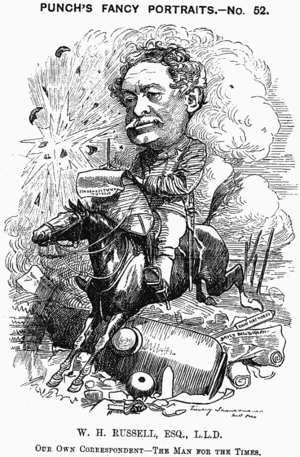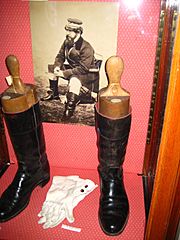William Howard Russell facts for kids
Quick facts for kids
William Howard Russell
|
|
|---|---|

William Howard Russell, ca. 1854
|
|
| Born | 28 March 1827 Tallaght, County Dublin, Ireland |
| Died | 10 February 1907 (aged 79) London, England |
| Occupation | Reporter, writer |
| Genre | Journalism |

Sir William Howard Russell (born March 28, 1827 – died February 10, 1907) was an Irish reporter for The Times newspaper. He is known as one of the first modern war correspondents. This means he reported directly from battlefields.
Russell spent 22 months covering the Crimean War. His reports from this war are seen as the world's first war correspondence. He also reported on other major conflicts. These included the Indian Rebellion of 1857, the American Civil War, and the Franco-Prussian War.
Contents
Reporting from the Battlefield
As a young reporter, Russell first covered a short military conflict. This was between Prussian and Danish troops in Denmark in 1850.
The Crimean War: Showing the Truth
In 1854, Russell was sent to Malta. His job was to report on British support for the Ottoman Empire against Russia. He did not like the term "war correspondent." However, his reports from the Crimean War made him famous around the world.
His writings showed the public the harsh reality of war. For the first time, people at home could read about what was really happening to soldiers. These reports shocked many people. They led the government to look at how troops were being treated.
Florence Nightingale later said his reports inspired her. She then went to help with wartime nursing. Russell also wrote about Mary Seacole. She was a nurse and healer who helped soldiers. He praised her skills, saying she had "a more tender or skilful hand about a wound."
Some soldiers did not like Russell. They saw him as someone who would get information from anyone. This reputation sometimes caused him problems. For example, the British commander, Lord Raglan, told his officers not to talk to Russell.
Famous Moments from Crimea
On September 20, 1854, Russell covered the battle at the Alma River. He wrote his report the next day. He described the "humane barbarity" of battlefield surgeons. He also noted the lack of ambulance care for wounded troops.
He later covered the Siege of Sevastopol. Here, he created the famous phrase "thin red line." He used it to describe British troops at Balaclava. He wrote that the Russians "dash on towards that thin red streak topped with a line of steel."
Russell's reports also highlighted the terrible conditions for Allied troops. He wrote about an outbreak of cholera. Because of his reports, a railway was built. This was the Grand Crimean Central Railway. It greatly helped the siege succeed. Russell left Crimea in December 1855.
Other Conflicts He Covered
In 1856, Russell went to Moscow. He described the coronation of Tsar Alexander II. The next year, he went to India. There, he saw the final re-capture of Lucknow in 1858.
In 1861, Russell traveled to Washington in the United States. He returned to England in 1863. In 1865, he sailed on the Great Eastern. He documented the laying of the Atlantic Cable. He wrote a book about this trip.
He also published diaries from his time in India, the American Civil War, and the Franco-Prussian War.
Life After the Frontlines
Russell stopped being a battlefield correspondent in 1882. He then started a newspaper called the Army and Navy Gazette.
He was given the title of Knight in May 1895. This meant he became "Sir William Howard Russell." He also received the Commander of the Royal Victorian Order (CVO) award in 1902. This award was given by King Edward VII himself.
Russell died in 1907. He is buried in Brompton Cemetery, London.
Personal Life
Russell was married twice. His first wife was Mary Burrows. After she passed away in 1867, he married Countess Antoinette Malvezzi. She was from Italy. They stayed married until his death. He had two sons and one daughter.
Legacy
Russell's reports from the Crimea are his most important legacy. He sent them using the telegraph. This was a new technology at the time. His reports brought the true horrors of war home to readers. This helped people understand what was happening far away.
His war reports were later collected into books. These books were called The War (1856) and History of the British Expedition to the Crimea (1858).
There is a statue of Russell in the crypt at St Paul's Cathedral in London.
See also
- War correspondent
External links
- The Special Correspondent
- Spartacus Educational: William Howard Russell



